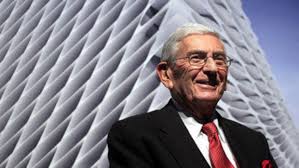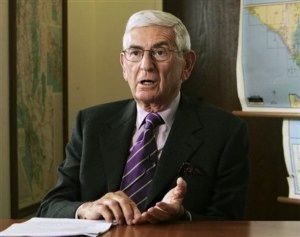Eli Broad and the Arts community

Here are two excerpts from The New York Review of Books which show the attitude in the arts community towards Eli Broad's influence on the arts.
This article is linked in "Who Is Eli Broad and why is he trying to destroy public education?" at Defend Public Education!
"The City’s Their Stage" by Martin Filler
New York Review of Books - September 27, 2012
A book review of:
"Diller + Scofidio: Blurred Theater
by Antonello Marotta, with a preface by Antonino Saggio
Rome: Edilstampa, 93 pp., $10.87 (paper)
Diller Scofidio + Renfro: Inside-Out, and Still Lincoln Center
Bologna: Damiani; distributed in the US by DAP/Distributed Art Publishers,
288 pp., $85.00
Diller Scofidio + Renfro: Institute of Contemporary Art (ICA) Boston
with photographs by Iwan Baan and a foreword by Jill Medvedow
Barcelona: Ediciones Polígrafa; distributed in the US by DAP/ Distributed Art Publishers, 77 pp., $25.00 (paper)
Diller, Scofidio, and Renfro (architects) have a most demanding patron in Eli Broad, the Los Angeles tract house developer and financial services tycoon who hired them in 2010 to design the Broad, a repository for his collection of contemporary art that will be open to the public, now in construction next to Gehry’s Walt Disney Concert Hall of 1987–2003 in downtown Los Angeles. Scheduled for completion in 2014, this commission has been fraught with ironies from the outset. Until just days before the opening of Piano’s Broad Contemporary Art Museum it had been assumed that the collector would give his extensive holdings to his eponymous gallery, but at the very last moment he announced that he was retaining ownership of his art after all.
Broad’s unexpected pullback shocked many observers, but cognoscenti were scarcely surprised. “Eli’s middle name is ‘strings attached,’” Christopher Knight, the art critic of the Los Angeles Times, observed on a 60 Minutes profile of Broad, and recipients of the meddlesome Maecenas’s funding have widely concurred. This self-styled “venture philanthropist”—a coinage that perfectly reflects his market-driven values—has given some $2 billion to cultural, educational, and other charitable causes, but he apparently expects that his largess also gives him the final word.
Broad twice hired and then fired Gehry (who vows he will never again work for the man he called a “control freak” on 60 Minutes), and Piano has made no secret that his BCAM scheme was badly compromised because of the donor’s rejection of the original light-filtering system as too expensive. Thus it will be interesting to see what this difficult client is able to accomplish with Diller, Scofidio, and Renfro.
Their plans for the $120 million new Broad—nearly twice the budget of BCAM, though at 120,000 square feet it is estimated at about $200 per square foot less than Piano’s design—are extremely promising, beginning with the building’s complex exterior, a honeycomb-like wraparound of glass-fiber reinforced concrete that brings to mind a larger-scale version of the cladding used by the SANAA group at their New Museum of 2003–2007 in New York.
**********
"A ‘Treacherous’ Art Scene?" by Julian Bell
The New York Review of Books - November 21, 2013
A review of Magicians and Charlatans: Essays on Art and Culture | Jed Pertl
Eakins, 358 pp., $45.00
...New York, uniquely dense in its cultural history, is the definite somewhere in which Perl is most likely to encounter an authentic, content-rich something, a fresh imaginative revelation.
The chances to do so seem to recede, however. Returning in 2008 from the opening of the Broad Contemporary Art Museum in Los Angeles, Perl takes the measure of the rehoused New Museum on the Bowery, and deems it likewise a “nowhere.” That is to say, another set of big, unfeeling warehouse interiors put forward behind a gratuitously whimsical façade that supplies the institution with its architectural “logo.” Such arbitrary box structures have been built to shelter spectacles that are equally meaning-lite, not so much artworks as “stunts”: they amount to no more than “brands designed to contain brands.” Perl infers that he is witnessing “a global phenomenon”: that all across the planet, these nowheres are springing up to display “trophy” acquisitions from the contemporary art market, tigers’ heads bagged from a notoriously wild and lawless economic jungle.
There is nonetheless some economic logic behind this behavioral pattern. Dave Hickey, slamming the door on art criticism last October, reckoned he was quitting the court of the hedge fund managers—“All we do is wander around the palace and advise very rich people.” Perl similarly shakes a fist at the unbridled cultural power the moneyed elite now possesses. For him, a man such as Eli Broad, the veteran entrepreneur who paid for the eponymous extension to the Los Angeles County Museum of Art but who retained possession of the Warhols and Jeff Koonses displayed inside it, does not operate from any serious wish to nurture public art appreciation: Broad is simply a “steamroller” of egotism, devoid of sensibility but determined to flaunt his “high-end shopping.”
Such invective is hollered boldly, but inconsequentially: Broad inhabits a plateau of power almost out of hearing range. Perl’s more targeted remarks are for those who like himself claim a prime commitment to the cause of art. A piece written two years after the 2004 reopening of MoMA circles warily around Glenn D. Lowry—then as now its director—suspecting that his “diabolically savvy” exterior masks an aesthetic apathy and that he is intent to “stifle a debate” about the surrender of the institution’s once-lofty ideals to the imperatives of fund-raising.
Presumably Perl has reprinted this criticism because he sees a vacuum of visual sensibility still obtaining, where once Alfred Barr and William Rubin pursued their fervent curatorial idiosyncrasies. While major institutions have been given over to placeholders who view the world through dollar-sign glasses, he observes that a new style of dealer has risen to the fore: a sensation-seeker dedicated not so much to individual reputations or even to money, but rather to “the next new thing” for the sake of its own novelty. Such an “opportunist” operator—Perl cites Jeffrey Deitch and Larry Gagosian—is “an enemy of all fixed or even evolving concepts of value.” The opportunist entrenches himself in a scene animated by
"apparently contradictory thoughts: that art is nothing; that art can be anything; that randomness and order are more or less the same thing; that art has no particular place in the world; that art can be found in any place in the world; that art is just another commercial product, like tennis balls and washing machines."
Between them, the megabuck art shopper, the fund-fixated museum director, and the trend-fixated dealer have now established a hegemony that wickedly shortchanges the viewer, in the eyes of Perl: he sees an American public that longs for the beauty and “particularity” of well-presented great art but that is left “hungry” and “disgruntled.”
Also see:
Eli Broad, at home with art
LA Times - March 20, 2011
The Broad Museum in Los Angeles to Open in September
The New York Times - February 5, 2015
Review: The Broad Is an Old-Fashioned Museum for a New Guilded Age
The New York Times - September 12, 2015
Hypocrisy on exhibit at L.A.'s Broad museum opening.
Fred Klonsky's blog - September 21, 2015.
Teachers Protest Eli Broad's Support for Charter Schools on His Museum Opening Day
Hyperallergic -September 25, 2015
Hyperallergic is an LA arts and culture magazine.
